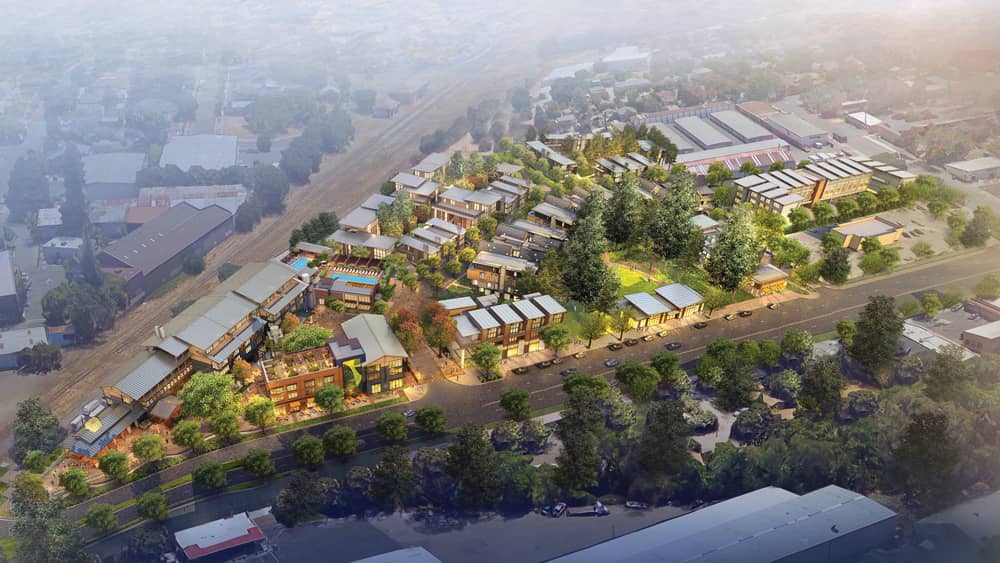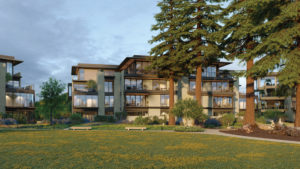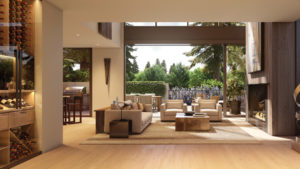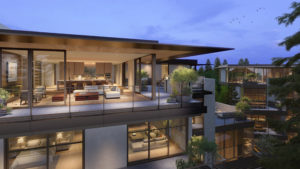
When David Hill, managing director of Replay Destinations, heard that almost 10 acres of prime land was available for redevelopment in Healdsburg, he didn’t believe it. It seemed impossible that a large parcel of land in such a desirable location, just a block from the city’s historic plaza, could be for sale, and yet—as he was soon to learn—it was true. The property belonged to Nu Forest Products, a wholesale sawmill that turned lumber into items such as siding, flooring and crown molding, and it had occupied the spot for more than 30 years. Its owners, however, wanted to move the operation to a parcel of land they owned in Cloverdale so the business could expand. In 2015, they were ready to sell, and officials of Replay Destinations visited to see the site firsthand in August of that year. The company acquired the property shortly after, but agreed to let Nu Forest stay for three more years to give the company time to prepare its facility in Cloverdale. Meanwhile, the vision of a mixed-use neighborhood with luxury, middle-income and affordable housing, a hotel, retail spaces and a park, all close to the future SMART station to make it transit-oriented, began to take shape.
Replay Destinations, an international destination real-estate company based in Vancouver, B.C., was founded in 2007 and has been operating since 2008. Its chairman, Joe Houssian, was a co-founder of Intrawest, a developer and operator of destination resorts, founded in 1976, that developed Whistler Blackcomb, one of the largest ski resorts in North America. The company grew to be one of the largest resort developers in the west and was sold in 2006. While with Intrawest, Houssian and Hill had acquired a unique skill set that gave Replay an advantage. “We have spent our careers in both development and operations,” Hill says. “That gives us the background to understand what people are looking for in the way of different life experiences.” His track record includes working on projects that are essentially redevelopment, whether they are former lumber mills or parking lots. “If it’s not redevelopment, then we put a significant emphasis on conservation,” he says.
The City of Healdsburg had already completed a comprehensive redevelopment plan with significant citizen input, and “It fit well with our guiding principles. It fit with the things we see from a lifestyle perspective,” he says. He explains that in the early 2000s, the Baby Boomers wanted to be active physically. Now, though, as they’ve aged, they’ve become more interested in food and wine, with social activities dominating their lives. “The redevelopment lines up well with the way Baby Boomers are living now,” he says.
When Mill District is complete, it will include luxury living in six to seven residential buildings, the first called Canopy, The Exchange, which is a building with affordable units, middle-income housing, a boutique hotel, a health, wellness and social facility for Mill District residents and retail spaces. The Preserve, a one-acre public park built around a grove of redwood trees, is the centerpiece, and although some people suggested removing the trees, “We were not about to cut them down. We made sure we protected those redwood trees,” says Hill. “Providing green as well as the buildings was important to us,” he adds, explaining that the idea is to create a pedestrian-friendly neighborhood, and the canopy of trees makes the walkways appealing.
Vision
When Replay develops a vision for a property, “We involve some of the best design and creative people that we can. We don’t know everything. You have to be a good listener to create a future vision,” says Hill. He lived in Healdsburg for several years during the planning stage, and made good use of his time there, contributing to the Central Healdsburg Entry Plan, south of the roundabout and meeting with members of the community. “We had an open-door policy and did a lot of community outreach,” he says. Healdsburg is an eclectic mix and doesn’t have neighborhoods based on socioeconomic status, he observes, and Replay is committed to providing housing for those who can’t currently afford to live in Healdsburg as well as those who can. Thus, they started with affordable housing and held a productive two-day community outreach session with city officials and stakeholders to determine what would make the ideal 40-unit building.

SB Architects of San Francisco, who are experts in designing hotels and in tune with Sonoma County, proved to be a good match for Mill District’s hotel, having designed the Farmhouse Inn expansion in Forestville and a major renovation of the Sonoma Mission Inn in Boyes Hot Springs. “We’re in a mixed-use zone,” says Hill, and Healdsburg’s downtown plan talks about serving visitors as well as residents, so the hotel and retail spaces add to Mill District’s diversity. With only 53 rooms, the size of the hotel, which has not yet been designed, is consistent with the scale of other hotels in the downtown area, and retail businesses will be in the hotel and along Healdsburg Avenue to invigorate that area. “We want [retail] to be driven by local products and operators,” he says. Although it’s too early to know the configuration or who the occupants will be, Hill anticipates a combination of businesses with some that serve local residents and others that attract visitors.
Olson Kundig, a Seattle-based architecture firm, turned out to be the best choice for designing Canopy. “When we interviewed them, the fit was perfect on multiple levels. It just became a very obvious relationship,” says Hill. The key is to find people with a shared set of values, he says, and once architects are chosen, the Replay team allows them freedom of expression and inspiration.
Inspiration
Olson Kundig is a global firm that works collaboratively on different types of projects that are often related to living and housing. Kirsten Ring Murray, the company’s design principal for Mill District, explains that they work in the context of the setting, whether it’s an urban or natural environment. “That’s really the key for us,” she says, adding that they have high expectations for quality and work with craftspeople and builders to create meaningful site-specific works. They look at the landscape, materiality and history and incorporate the conceptual ideas into a design, often integrating indoor and outdoor living. “That is particularly important for this project,” she says, adding that the many different elements such as climate, nature, landscape, wood, distant views and soft mountains must be taken into consideration. “It’s a beautiful place,” she says, with old and new buildings nearby, a rich history and the opportunity to create housing on the edge of a park on the sliver of an old industrial site. She describes Healdsburg as a wonderful, traditional agricultural town with a town square, a pedestrian network and buildings that have an almost perfect scale relationship to its small urban center. Mill District is adjacent to downtown. “We’re hoping to pull that pedestrian experience and scale into this design,” she says.

The interiors are designed to be gracious units that will give residents the ability to live well. Wood is used inside rather than out to help make the buildings fire resistant, and the flooring and cabinetry reflect the area’s agricultural and mill history, while a variety of stone is reminiscent of the Russian River. Residents might have collections of art, and so the walls are intentionally designed to provide opportunities to display art in an easy yet dramatic manner. “When we’re doing bathrooms, we’re creating gracious spa-like conditions,” says Murray, with great views, light, air and ample space for people to enjoy taking care of themselves. Generous decks on all units give residents the opportunity to do serious kitchen gardening, and some of the two-story garden homes also have little dip-in pools.

Chef Kyle Connaughton, co-owner of SingleThread, a three-Michelin-starred restaurant in downtown Healdsburg, is assisting with the design of custom kitchens and selecting equipment. “As chefs, we consider the flow of the layout a reflection of cooking style, so it only makes sense to be involved in the overall design,” he explains. He has an initial consultation with homebuyers and considers their culinary preferences, as well as the ways they want to use their kitchens and how they entertain. The kitchens are equipped with high-quality, German-engineered Miele appliances, which contribute to creating outstanding culinary experiences. He believes that the residences at Canopy reflect Sonoma County’s approach to food and wine, which he describes as “cooking and eating with the seasons, harvesting fresh herbs and greens from the terraces and gathering over long, leisurely meals under the stars.” He adds that wine storage is a feature of each unit, and Rusty Rastello, SingleThread’s wine director, will assist homeowners with wine education and curation, as well as storage. Connaughton is pleased to help build something special in the community. “We love where we live, and welcoming our new neighbors to Healdsburg is incredibly rewarding,” he says.
The buildings for Canopy are in different phases of development, and Murray says that each is in an area with its own unique characteristics, such as size and solar conditions, which the design will respond to. “What ties them together is the desire to have a pedestrian-driven environment,” she says, along with access to the park.
Connections


Mill District is a multi-year endeavor. “The whole project is a work in progress,” says Hill, and he is pleased with the collaboration with the city and its residents. “That makes me hopeful it will turn out really well,” he says. However, creating a new neighborhood and integrating it with the current community is a delicate balance. “We’ve done everything we can from a planning perspective, and we have also tried not to overplan it. It needs a bit of organic growth,” he says. To explain, he gives the example of a crane with a building hanging from the end. Some developers simply drop in a building without respect for its surroundings, but Replay Destinations considers the site as a whole and makes sure all the parts complement each other. “We like to take the opposite approach,” he says. “Every one of these components is like a custom-tailored suit. It has to fit just right.” Mill District is only in phase one, and more is yet to come, so they’ll proceed carefully, continue to listen and keep refining the various pieces until Mill District becomes something its owners can be proud of. No one has moved in yet, and without people to bring the neighborhood to life, its future character is difficult to predict. “We hope it will become a model for small-town living in an urban environment,” Hill says. Meanwhile, Mill District is a welcome addition to Healdsburg with all the right ingredients, and everyone involved is optimistic that it will live up to its potential.
Tax Credits
Low-Income Housing Tax Credit Programs are federal programs that subsidize the construction, acquisition or rehabilitation of affordable housing for low and moderate-income families and individuals by issuing tax credits to the states and territories.
In California, the California Tax Credit Allocation Committee allocates federal and state tax credits to private developers of affordable rental housing for low-income residents of the state in a competitive process. The developers then usually sell the credits to private investors, who provide funding for developments in exchange for the tax credits. Developers must meet all the program’s requirements and guarantee that the housing will remain affordable and in service for 55 years. The investors can claim the LIHTC after the project goes into service for a period of 10 years.
taxpolicycenter.org
treasurer.ca.gov



